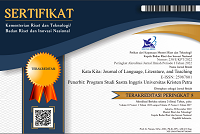The Use of Mother Tongue in General English Program for Teenagers in the Second and Fourth Levels
DOI:
https://doi.org/10.9744/katakita.2.2.46-53Keywords:
Creativity, Hobby, Model kit, SurabayaAbstract
This study reports the teacher’s use of mother tongue (Bahasa Indonesia) in English as Foreign Language (EFL) classroom in Indonesia. The study was conducted in an English language course for teenagers, and focused more in the second and fourth level. It was revealed that beside English language, Bahasa Indonesia was used by the teachers as the medium of instruction for some functions: conveying and checking the meaning of words/sentences, explaining grammar, organizing tasks, maintaining discipline, and gaining contact with individual student; and the teachers’ reason in using Bahasa Indonesia was to make sure that the students understand about what they delivered. In addition, some similarities and differences were found in the comparison of the second and fourth levels.
References
Ahsan, S., & Islam, M. J. (2011) Use of Bangla in EFL classes: the reaction of the secondary level students and the teachers in Bangladesh. ASA University Review, 5(2), 197 – 222.
Charalambous, C., Philippou, G.. & Kyriakides, L. (2002). Towards understanding teachers’ philosophical beliefs about mathematics. In Proceedings of the Annual Meeting of the International Group for the Psychology of Mathematics Education (Norwich, England).
Cook, V. (2001). Using the first language in the classroom. The Canadian Modern Language Review, 57(3), 402 – 423.
He, A. E. (2012). Systematic use of mother tongue as learning/teaching resources in target language instruction. Multilingual Education: A Springer Open Journal, 2(1), 1 – 15.
King, H., & Nash, C. P. (2011). Bilingual teacher beliefs and practice: do they line up? Gist Education and Learning Research Journal, 5, 66 – 83.
Kohler, M., & Mahnken, P. (2010). The current state of Indonesian language education in Australian schools. Australia: Education Services Australia Ltd.
Pokharel, B. R. (2001). Applied Linguistic. Kathmandu: Jupiter Publishers and Distributors.
Richardson, V. (1996). The roles of attitudes and beliefs in learning to teach. In J. Sekula. (Ed.), Handbook of research in teacher education (pp. 102 – 119). New York: Mcmillian.
Tang, J. (2002). Using L1 in the English classroom. English Teaching Forum, 40(1), 36 – 43.
Zacharia, H. (2002). Come on in, mother tongue: evaluating the role of mother tongue in English language teaching in Indonesia. Retrieved April, 28th 2013 from https://sites.google.com/site/hennyeboard/system/app/pages/search?scope=search-site&q=come+on+in+mother+tongue
Downloads
Issue
Section
License
Authors who publish with this journal agree to the following terms:- Authors retain copyright and grant the journal right of first publication with the work simultaneously licensed under a Creative Commons Attribution License that allows others to share the work with an acknowledgement of the work's authorship and initial publication in this journal.
- Authors are able to enter into separate, additional contractual arrangements for the non-exclusive distribution of the journal's published version of the work (e.g., post it to an institutional repository or publish it in a book), with an acknowledgement of its initial publication in this journal.
- Authors are permitted and encouraged to post their work online (e.g., in institutional repositories or on their website) prior to and during the submission process, as it can lead to productive exchanges, as well as earlier and greater citation of published work (See The Effect of Open Access).














